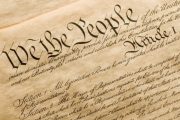Since the soul-shaking murder of 20 children and six adults at the Sandy Hook Elementary School in Newtown, Connecticut, one week ago, thousands of articles have been written calling for increased federal control over the right of an individual to own a gun. Such proposals are perhaps an expected though ineffectual and unconstitutional reaction to an event so horrific and inexplicable.
Of course, the right to “bear arms” is explicitly protected by the Second Amendment to the Constitution and should not be subject to arbitrary and knee-jerk abridgment by those who wrongly believe that limiting access to weapons would effect a proportional decrease in violent crime.
There are many who insist that safety at school, specifically, and at home, generally, would increase were we to impose tighter restrictions on the ability to obtain firearms.
For example, in his statement following the rampage in Newtown, President Obama hinted that such stricter proposals will be forthcoming:
Can we honestly say that we’re doing enough to keep our children — all of them — safe from harm? Can we claim, as a nation, that we’re all together there, letting them know that they are loved, and teaching them to love in return? Can we say that we’re truly doing enough to give all the children of this country the chance they deserve to live out their lives in happiness and with purpose?
I’ve been reflecting on this the last few days, and if we’re honest with ourselves, the answer is no. We’re not doing enough. And we will have to change.
Many observers are right to worry that those changes will include infringements on the Second Amendment’s guarantee of the right to bear arms. And while gun ownership and the unalienable right thereto is at the core of the Second Amendment, the protection provided before the right to bear arms is equally important to the maintenance of liberty and the safety of the people.
“A well regulated Militia, being necessary to the security of a free State … shall not be infringed.”
The right to muster and maintain a militia was not invented in Philadelphia in 1787. As Edwin Vieira, Jr. observed in The New American in 2009:
The Amendment did not purport to create, for the first time in 1789, “the right of the people to keep and bear Arms,” though. Instead, it recognized that right’s prior existence, in order to guarantee its future exercise. Indeed, the original Constitution actually required both the General Government and the States, not just to protect, but also affirmatively to promote, that exercise. This is because the original Constitution incorporated within its federal structure “the Militia of the several States.”
Furthermore, despite President Obama’s implication of an association between gun ownership and public safety, for over 600 years, Anglo-American legal tradition explicitly has recognized the presence of an armed populace as a reliable deterrent to mayhem.
In the Statute of Northampton enacted in 1328, for example, an exemption to restrictions on the carrying of weapons in the presence of the king or his ministers was carved out for situations where there is “a cry made for arms to keep the peace, and the same in such places where such acts happen.”
As for the need for a state militia and the role of them in the protection of liberty, the Founding Fathers could not have been clearer in their statements in that regard.
In Federalist, No. 46, James Madison wrote that should the unthinkable (to him) happen and the federal government overrun the high fences placed by the states around its constitutional powers, every foxhole in the field of the battle over the exercise of sovereignty would be filled with members of the state militias.
George Washington, perhaps better than anyone, understood that a well-trained but otherwise ad hoc army composed of state militias could be powerful enough to defeat the invading forces of a mighty empire. The general recognized the urgent need for a disciplined, organized, and independent state militia. As the continental commander-in-chief, Washington knew very well that training an army of citizen soldiers — many of whom used their muskets for little more than hunting — was crucial to restoring the freedom of America. In fact, it was the need for a more well-regulated force that compelled Washington to hire Friedrich von Steuben to drill the soldiers of the Continental Army.
His experience in the War for Independence likely inspired this quote, as well: “A free people ought not only to be armed and disciplined, but they should have sufficient arms and ammunition to maintain a status of independence from any who might attempt to abuse them, which would include their own government,” Washington warned.
Heedless, most states of the United States have failed to maintain an armed and disciplined militia capable of maintaining (or regaining) their independence.
Tim Baldwin, an attorney and author from Montana, commented ably on the failure of states to maintain a militia capable of repelling a federal armed force. Writes Baldwin:
It is a proven maxim that States have the duty and right to protect and sustain themselves. It is also a maxim that every government owes to its citizens protection (e.g. 49-1-201, Mont. Code Ann., “Every person while within the jurisdiction of this state is entitled to its protection”; Art. 1, Sec. 10, USC). In spite of the Second Amendment’s prescription that the States maintain a well-regulated militia to secure a “Free State” and the State constitutions and laws requiring State militias to protect the State’s homeland, there is not one State that is capable of protecting the citizens from domestic or foreign invasion.
Baldwin is right. An organized militia, considered by Madison to be last line of defense against a federal government bent on reducing states to subjects, is not only rejected by most even within the liberty movement, but is considered by establishment types to be an embarrassment and a lunatic fringe of the Right that must be shunned by all right-minded conservatives.
The plan to marginalize militias has been startlingly successful. There remain only 23 state defense forces (not including units of the National Guard and Reserve, which are under the command of the president and are effectively just reserves of the federal armed forces). The problem, however, is that even these state-run militias are not militias in the sense that Madison and the Founders were familiar with and that were counted on to repel federal invasions.
In its decision in the 1990 case of Perpich v. Department of Defense 496 U.S. 334 (1990), the Supreme Court effectively federalized even state defense forces. The ruling, although explicitly claiming not to be ruling on the issue of the status of the state defense forces, referenced a few federal statutes that seem to support an inference of federalization of these ersatz militias.
The Supreme Court held: “It is true that the state defense forces ‘may not be called, ordered, or drafted into the armed forces.’ 32 U.S.C. 109(c). It is nonetheless possible that they are subject to call under 10 U.S.C. 331-333, which distinguish the ‘militia’ from the ‘armed forces,’ and which appear to subject all portions of the ‘militia’ — organized or not — to call if needed for the purposes specified in the Militia Clauses.”
The following is a sample of the federal laws cited by the Supreme Court as being likely sources of federal government authority over state defense forces:
10 USC 331 — “Federal aid for State governments”
Whenever there is an insurrection in any State against its government, the President may, upon the request of its legislature or of its governor if the legislature cannot be convened, call into Federal service such of the militia of the other States, in the number requested by that State, and use such of the armed forces, as he considers necessary to suppress the insurrection.
10 USC 332 — “Use of militia and armed forces to enforce Federal authority”
Whenever the President considers that unlawful obstructions, combinations, or assemblages, or rebellion against the authority of the United States, make it impracticable to enforce the laws of the United States in any State or Territory by the ordinary course of judicial proceedings, he may call into Federal service such of the militia of any State, and use such of the armed forces, as he considers necessary to enforce those laws or to suppress the rebellion.
10 USC 333 — “Interference with State and Federal law”
The President, by using the militia or the armed forces, or both, or by any other means, shall take such measures as he considers necessary to suppress, in a State, any insurrection, domestic violence, unlawful combination, or conspiracy, if it
(1) so hinders the execution of the laws of that State, and of the United States within the State, that any part or class of its people is deprived of a right, privilege, immunity, or protection named in the Constitution and secured by law, and the constituted authorities of that State are unable, fail, or refuse to protect that right, privilege, or immunity, or to give that protection; or
(2) opposes or obstructs the execution of the laws of the United States or impedes the course of justice under those laws.
In any situation covered by clause (1), the State shall be considered to have denied the equal protection of the laws secured by the Constitution.
History demonstrates that the court is happy to give its sister branches an inch of authority through which they can shove a mile of tyranny! That means that even though 23 state governments have organized and mustered state defense forces in addition to the National Guard and Reserve units that are subordinate (in all meaningful ways) to the federal armed forces, the Supreme Court has opened a gap in the independence of those forces large enough to allow the president to insist that these citizen soldiers are his to command, and should they dare sound the call to defend their home states against the execution of unconstitutional federal mandates, they are subject to suppression by the president.
Given his signing in 2011 of the National Defense Authorization Act (NDAA), his signal to the United Nations of his administration’s support for the UN arms trade treaty that would impose additional controls on individual gun ownership, and his statements made after the Sandy Hook Elementary massacre, there remains little doubt as to how liberally President Obama would interpret the word “suppression.”




